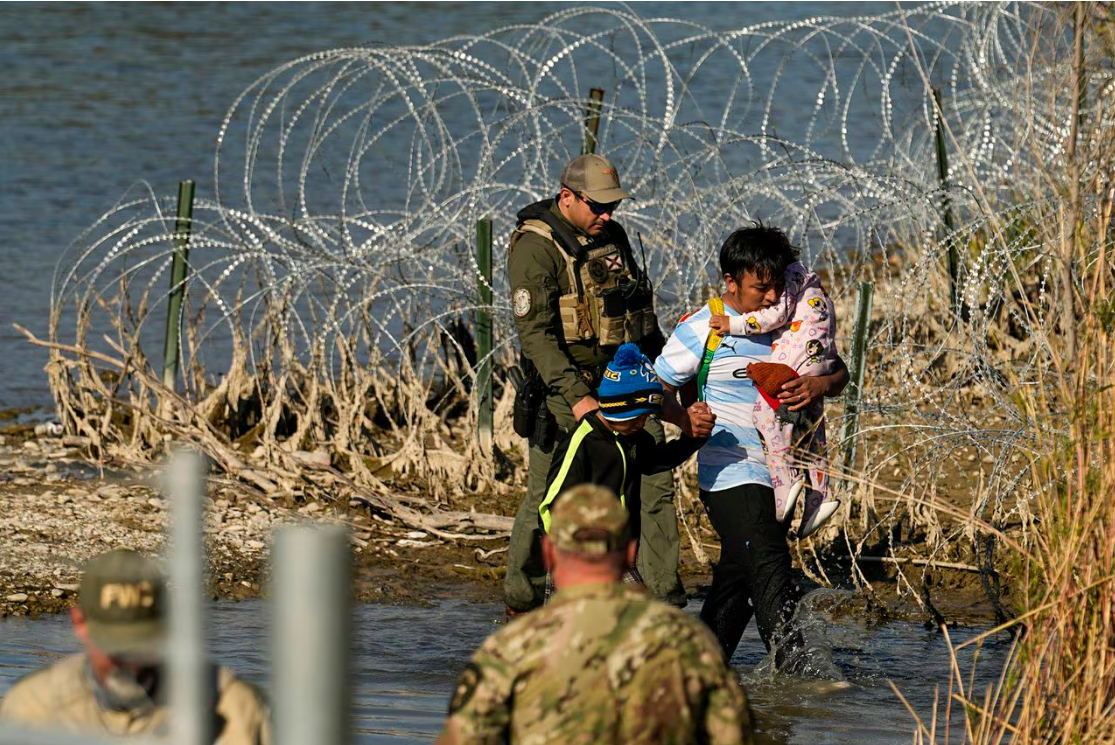法官下令为在边境等待的移民儿童及时提供住房

【中美创新时报2024 年 4 月 4 日编译讯】美国地方法院法官周三晚间裁定,联邦政府必须“迅速”安置非法进入美国的移民儿童,而不是允许他们留在边境沿线不安全的露天场所。《纽约时报》记者Emily Baumgaertner对此作了下述报道。
这项裁决是由美国加州中部地区法院法官多莉·M·吉 (Dolly M. Gee) 做出的,该裁决主要支持集体诉讼中代表孩子们的律师。 它规定,这些地点的未成年人受到国土安全部的合法监护,因此即使尚未得到正式处理,也有权享有某些权利和保护,例如安全和卫生的环境。
该法院命令立即生效,预计将影响数千名儿童,甚至可能影响更多儿童。 这可能会迫使美国海关和边境保护局投入更多资源来跟上移民的流动。 该机构表示,它已经将圣地亚哥处理中心的容量增加了两倍多,并增加了运输巴士和人员的数量,以加快逮捕速度。
这项裁决是在围绕未经许可进入美国的移民(包括儿童)的权利展开激烈的政治和文化辩论之际作出的。 由于美墨边境过境点大量涌入,圣地亚哥县南部的移民处理中心人满为患,移民在临时营地等待数小时甚至数天才能被拘留。
到目前为止,露天营地仅在加利福尼亚州,但该命令中的语言并不限于该州,因此如果其他边境州出现类似的营地,该裁决可能会适用。
户外地区缺乏住所、食物和卫生设施,这给最弱势群体带来了一系列公共卫生问题。 据现场的救援人员和医疗志愿者称,无人陪伴的儿童和年轻家庭有时健康状况不佳,患有外伤或慢性疾病,需要的药物早已用完。
据援助组织称,在炎热的沙漠日子里,脱水和中暑已成为常见问题,而夜间气温、风和雨为体温过低创造了条件。 医生特别关注儿童的这些因素,因为许多儿童的体脂低于成人,并且可能因旅途而营养不良。
政府辩称,这些孩子尚未被美国拘留,因此没有义务提供服务。 法官援引边境巡逻人员对未成年人离开现场的能力的控制以及他们影响儿童是否获得援助和医疗的权力作为其裁决的理由。
这份长达 12 页的命令写道:“能够对儿童的健康和福利行使自由裁量权并做出影响儿童健康和福利的决定,表明维持对儿童的合法监护权,无论该决定是提供还是停止照顾。” “青少年与成年人不同,总是受到某种形式的拘留。”
吉拒绝了律师关于未成年人可以在这些地点被关押的具体时间限制的要求,但表示国土安全部需要“迅速”处理所有儿童,并将他们安置在安全、卫生和“一致”的设施中。 国土安全部对未成年人的特殊脆弱性的关注。”
她说,边境巡逻人员必须停止引导未成年人前往这些地点或将他们拘留在这些地点,“除非国土安全部合理要求为未成年人做好准备和/或积极安排将未成年人运送到更合适的设施。”
代表这些孩子的律师辩称,应该根据 1997 年的一项同意令(称为弗洛雷斯和解协议)为他们提供住房和服务。 该协议规定了政府监管下的移民儿童的待遇标准,要求他们获得厕所、食物和饮用水等基本供给,并且通常将他们关押在经国家许可的儿童照料设施中 在儿童福利体系中。 律师们在二月份提出了一项动议,寻求对露天场所的儿童执行这些条款。
问题是,单独或与家人一起跨越南部边境的儿童是否应由联邦政府负责,而他们仍留在户外地区等待向美国边境当局投降。
在动议中,律师们辩称,尚未被正式逮捕的儿童应享有与已被正式拘留的儿童相同的安全和卫生的住房,因为他们被禁止离开营地,也无法越过边境返回。
对此,司法部律师辩称,由于孩子们尚未被美国海关官员正式拘留,因此他们没有义务提供此类服务。 他们并不否认营地的条件很差。
辩护律师写道:“美国海关和边境保护局一直在迅速逮捕未成年人并将其运送到安全卫生的美国边境巡逻设施。” “但在此之前,原告不会被国土安全部拘留,”他们说。
美国海关和边境保护局的一名高级官员表示,他无法对法律问题发表评论,但强调目前的移民系统不具备应对涌入边境的移民的能力。 他指出,法院的裁决并没有带来额外的资源来使命令更容易实现。
法院的最新裁决承认这些“实际困难”,但表示该机构“没有尽可能迅速地处理集体成员”,并援引证据表明该机构“发现有能力在审查时更有效地处理儿童”。
本文最初发表于《纽约时报》。
题图:1 月 3 日,德克萨斯州与墨西哥边境的官员在德克萨斯州伊格尔帕斯 (Eagle Pass) 拘留了移民。ERIC GAY/美联社
附原英文报道:
Judge orders timely housing for migrant children waiting at border
By Emily Baumgaertner New York Times,Updated April 4, 2024
The federal government is required to “expeditiously” house migrant children who cross into the United States unlawfully, rather than allow them to remain in unsafe open-air sites along the border, a US District Court judge ruled Wednesday night.
The decision, handed down by Judge Dolly M. Gee of the US District Court of Central California, sided mostly with the lawyers representing the children in a class-action lawsuit. It established that minors at the sites were in legal custody of the Department of Homeland Security and thus were entitled to certain rights and protections, such as a safe and sanitary environment, even if they had not yet been formally processed.
The court order, which takes effect immediately, is expected to affect thousands of children and potentially many more. It will likely force US Customs and Border Protection to devote additional resources to keeping up with the flow of migrants. The agency said it had already more than tripled the capacity at processing centers in San Diego and that it had increased the number of transport buses and personnel in order to expedite apprehensions.
The ruling comes amid a fierce political and cultural debate over the rights of migrants — including children — who enter the United States without permission. Because of an influx in crossings at the US-Mexico border, immigration processing centers in southern San Diego County are strained, and migrants have waited for hours or sometimes days at makeshift camps to be taken into custody.
So far the open air encampments are only in California but the language in the order was not limited to the state, so if similar camps arise in other border states, the ruling would likely apply.
The outdoor areas lack shelter, food, and sanitation, which has given way to an array of public health concerns for the most vulnerable. Unaccompanied children and young families sometimes arrive in poor health, according to aid workers and medical volunteers at the sites, suffering from traumatic injuries or chronic health conditions that require medications that have long since run out.
During the hot desert days, dehydration and heat stroke have become common problems, according to aid groups, and nighttime temperatures, wind, and rain are creating conditions ripe for hypothermia. Doctors are particularly concerned about those elements for children, since many have lower body fat than adults and may be malnourished from their journeys.
The government had argued that the children were not yet in US custody so it had no obligation to provide services. The judge cited Border Patrol agents’ control over the minors’ ability to leave the sites — and their power to affect whether the children have access to aid and medical treatment — as the rationale for her ruling.
“The ability to exercise discretion over, and make decisions affecting, a child’s health and welfare is indicative of maintaining legal custody of the child, regardless of whether that decision is to provide or withhold care,” the 12-page order read. “Juveniles, unlike adults, are always in some form of custody.”
Gee denied the lawyers’ request for a specific time limit for how long minors could be held at the sites, but said the Department of Homeland Security needed to process all children “expeditiously” and place them in facilities that are safe, sanitary and “consistent with DHS’s concern for the particular vulnerability of minors.”
She said that Border Patrol officers must stop directing minors to the sites or holding them in the sites “except for the amount of time DHS reasonably requires to prepare the minor and/or actively arrange for transport of the minor to a more suitable facility.”
The lawyers who represented the children had argued that they should be given housing and services under a 1997 consent decree known as the Flores settlement agreement. That agreement established the standards of treatment for immigrant children in government custody, requiring that they be given access to basic provisions like toilets, food, and drinking water, and that they generally be held in facilities that are licensed by the state to care for children in the child welfare system. The lawyers filed a motion in February seeking to enforce those terms for children at open-air sites.
The issue was whether children who crossed the southern border, alone or with their families, were the responsibility of the federal government while they remained in the outdoor areas waiting to surrender to US border authorities.
In the motion, the lawyers argued that children who have not yet been formally apprehended deserve the same safe and sanitary housing as those already in official custody, since they are forbidden from moving from the camps and have no way of going back over the border.
In response, lawyers for the Department of Justice argued that because the children had not yet been formally taken into custody by US customs officials, they were not obligated to provide such service. They did not dispute that the conditions in the encampments were poor.
“CBP has been apprehending and transporting minors to safe and sanitary US Border Patrol facilities in a prompt manner,” the defense lawyers wrote. “But until that occurs, plaintiffs are not in DHS custody,” they said.
A senior official at US Customs and Border Protection said he could not comment on the legal matter, but emphasized that the current immigration system was not equipped to handle the influx of migrants arriving at the border. He noted that court rulings did not come with additional resources to make the orders more achievable.
The latest ruling from the court acknowledged those “practical difficulties” but said the agency “has not been processing class members as expeditiously as possible,” citing evidence that it “finds the ability to process children more efficiently in times of scrutiny.”
This article originally appeared in The New York Times.

